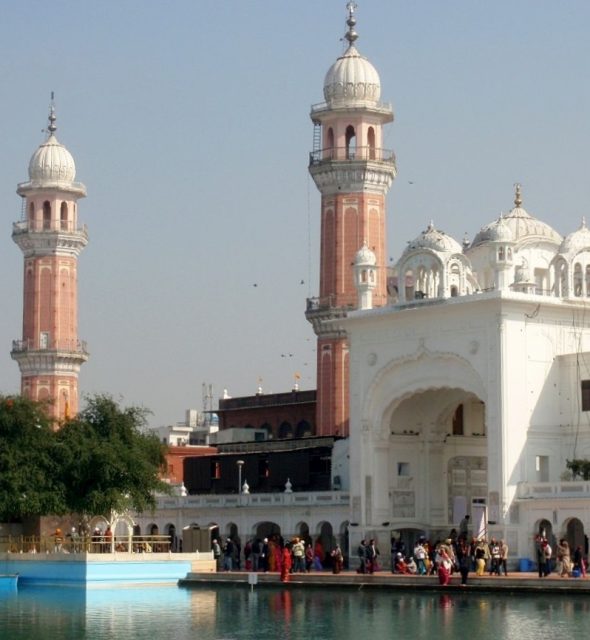BHAGATU, BHAI (d. 1652), a devoted Sikh who served the Fifth, Sixth and the Seventh Gurus, was the son of Adam (Uddam in some chronicles), a Siddhu Brar of Malva country. Sikh chronicles record that Adam, without a son for a long time and despaired of prayers at the feet of different holy men, Muslim as well as Hindu, was advised by a Sikh to go to Guru Ram Das. Adam reached Amritsar and dedicated himself to the service of the Guru and the sangat. The Guru was pleased by his humility and sincerity. Adam received his blessing and had a son born to him. Bhagatu, as the son was named, grew to be a saintly person with a firm faith in the Guru.
BHIKHA(pronounced as Bhikkha), BHATT. a Brahman bard of Sultanpur Lodhi in present day Kapurthala district of the Punjab, became a Sikh receiving the rites of initiation at the hands of Guru Amar Das. He lived up to the time of Guru Arjan to whom he introduced sixteen other Brahman minstrels from his community. They sang in his presence praises to God and the Gurus. Some of their compositions were included by Guru Arjan in the Guru Granth Sahib. One of the two stanzas by Bhikha recounts his wanderings in search of a true saint ending with his ultimate success by the grace of God. "Lord," sang the bard, "hath caused me to meet the Guru; as thou wiliest for me so must I receive 0 God !"
BRAHMO SAMAJ. The expression "Brahmo Samaj" (correct transcription, "Brahma Samaja") literally stands for a society of the worshippers of Brahman, the Supreme Reality, according to Hindu philosophy. It is the name of the Theistic Church founded by Raja Rammohun Roy (1772-1833), in Calcutta on 20 August 1828. The history of the movement leading to the foundation of this "house of worship" is intimately bound up with that of the individual career of Rammohun Roy.

BUNGA: A place of residence for the Sikhs or the place for rest for the pilgrims. There were at least 69 Bungas at Amritsar in the nineteenth century, some of them are still in existence. Another term for the resting hostel for the Sikh pilgrims is Saran. At Darbar Sahib, Amritsar Guru Ram Das Saran has been built for the pilgrims. Another Saran at Darbar Sahib is named Guru Nanak Niwas. Lately, a paid hostel named Aka/ Rest House, too, has been built. There are Sarans attached to almost all of the major Gurdwaras.
CHITTAGONG (22° 21`N, 91° 50`E), a major port town of Bangladesh, situated on the right bank of Karnaphuli River, 20 km from its mouth, has a historic Sikh shrine, called Gurdwara Sikh Temple, dedicated to Guru Nanak, who is believed to have stayed here briefly in 1507-08. Local tradition connects this Gurdwara with the story of the conversion by Guru Nanak of Bhai Jhanda Badhi, Raja Sudhar Sen and his nephew, Indra Sen. The story occurs briefly in the B40 Janamsakhi and at some length in the Bala Janam Sakhi. Gurdwara Sikh Temple is situated in the middle of Chowk Bazar. An old well adjoining it is still in use.
DARSHAN SINGH PHERUMAN (1885-1969), political leader and martyr, was born at the village of Pheruman, in present day Amritsar district, on 1 August 1885. His father`s name was Chanda Singh and his mother`s Raj Kaur. After passing his high school examination, he joined in 1912 the Indian army as a sepoy. Two years later, he resigned from the army and set up as a contractor at Hissar. He was doing well as a contractor, when a taunt from his mother, who was deeply religious, led him to give up his business and plunge into the Akali movement for the reform of Gurdwara management.
DHARAM SINGH, BHAI (1666-1708), one of the Pan] Piare or the Five Beloved, the forerunners of Khalsa, came of farming stock. He was the son of Bhai Sant Ram and Mai Sabho, of Hastinapur, an ancient town on the right bank of the Ganges, 35 km northeast of Meerut (29°N, 77° 45`E). Dharam Das, as he was originally named, was born around 1666. As a young man, he fell into the company of a Sikh who introduced him to the teachings of the Gurus. He left home at the age of thirty in quest of further instruction. At the Sikh shrine ofNanak Piau, dedicated to Guru Nanak, he was advised to go to Guru Gobind Singh at Anandpur, where he arrived in 1698.
GONDA, BHAI, a devoted Sikh of the time of Guru Har Rai (1630-61). He was sent to Kabul to Dreach Guru Nanak`s word and he esiabhshed there a dharamsal. According to Sarup Das Bhalla. Mnhimd Prakdsh, one day as he sat in contemplation concentrating his mind on the Guru`s feet, he fell into a trance.








